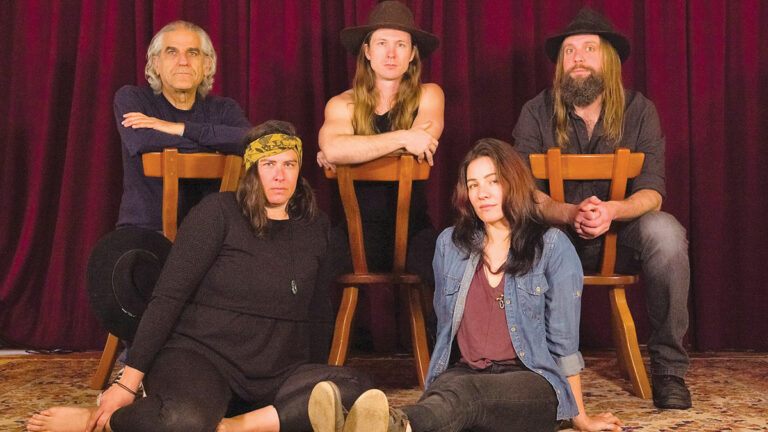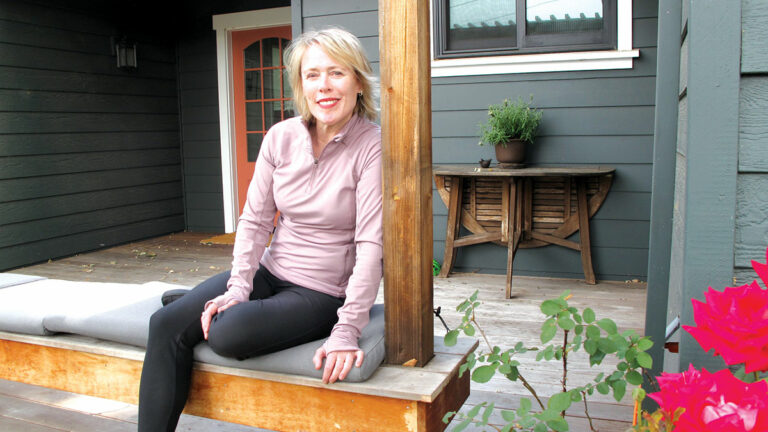A weekly guide to what’s happening.
ARTS AND MUSIC
COMMUNITY DRUMMING WITH JIM GREINER IN PERSON Percussionist and educator Jim Greiner will conduct the next in his monthly Third Friday series of community drumming sessions at the Inner Light Center in Soquel in person. Doors open at 5:45pm. The cost is $10. Masks and social distancing requirements will be honored. Jim makes it fun and easy for people from all walks of life to play drums and hand percussion to release stress, to uplift and energize yourself, and to reinforce positive life rhythms through percussion playing. Friday, May 21, 6-7:30pm. Inner Light Center, 5630 Soquel Drive, Soquel.
KEEP ON TRUCKIN’ Powered by Tandy Beal and Company and a lot of great friends, this event presents exceptional artists in free 15-minute mini-shows on a flatbed truck outside. Knowing that everyone is a bit stressed, we are offering this taste of music and circus to uplift our neighborhoods. Keep each other safe, wear your masks and keep your distances social—otherwise, the truck will need to move on. Each stop on our Truckin’ Tour will be a 20-minute performance: 11am at Garfield Part (199 Seaside St.); 11:45am at University Terrace Park (369 Meder St.); 12:30pm at Westlake Park (Bradley Drive and Majors St.); 2:15pm at Ocean View Park (102 Ocean View Ave.); 3pm at Frederick St. Park (168 Frederick St.). More information at tandybeal.com. Saturday, May 22, 11am-3pm. Sunday, May 23, 11am-3pm.
T BONE MOJO BAND INSIDE DAVENPORT ROADHOUSE Veterans of the 1960s San Francisco and East Coast music scenes present a fun and groovin’ up-energy group, often featuring special guests geared to getting the party going, folks tapping their feet, and on the dance floor! Saturday, May 22, 5-8pm. Davenport Roadhouse Restaurant and Inn, 1 Davenport Ave., Davenport.
VIRTUAL TWO-ACT PLAY BY HIROSHI KASHIWAGI The two-act play is a love story about a young Nisei couple who meet at Tule Lake and fall in love but are torn apart by two controversial, government-issued “loyalty” questions. Forty years later, they meet again and discover their answers to these questions had consequences that affected them for the rest of their lives. The controversial questions 27 and 28 tore the community apart and sent shockwaves of resentment, fear and division in the American concentration camps. Families were divided and no one was certain how the questionnaire would be used by the government. The stigma of answering “No” to both of these loaded questions would last for decades. “The Betrayed” illustrates how the questions led to divisiveness and disruption in the Japanese American community. The author Hiroshi Kashiwagi wished that an open and honest portrayal of the complex issue would bring about reconciliation and healing. During the post-screening discussion, supporters will have a chance to meet cast members Helen Ota and Michael Palma, and discuss the long-term effects of the loyalty controversy with Dr. Satsuki Ina and Soji Kashiwagi, executive director of Grateful Crane and son of Hiroshi Kashiwag. Benefit screening for the Watsonville Buddhist Temple. Donation: $25 per person/$50 per household. Tickets available at eventbrite.com; search “The Betrayed”. Ticket holders will receive an email with the link to the virtual play 48 hours prior to the showing. As a courtesy to those who may not be able to view the play at the scheduled time, ticket holders can view the taped play for 36 hours after the live performance. Saturday, May 22, 4:30pm. Watsonville Buddhist Temple, 423 Bridge St., Watsonville.
TOP DOG FILM FESTIVAL We will have a limited capacity, opening night, live audience screening. We will be following local Covid protocols. Celebrate the canine connection through this carefully curated collection of heartwarming stories about dogs and their people at the 2021 Top Dog Film Festival. The 2021 Top Dog Film Festival presents a two-hour cinematic celebration honoring the bond between dogs and their people. Filled with delightfully doggy moments of joy and celebration of our beloved canine companions. This program of short canine-themed films is comprised of the most inspirational, heart-warming and entertaining stories about dogs and their human companions, from independent filmmakers around the globe. Get your tickets before they all sell out —you’d be barking mad to miss it! If you aren’t ready for an in-person theatre experience, there is also a virtual screening held at 7pm from May 14-24. Visit riotheatre.com for more information.
COMMUNITY
EFFECTIVE COMMUNICATION STRATEGIES WEBINAR Communication is more than just talking and listening—it’s also about sending and receiving messages through attitude, tone of voice, facial expressions and body language. As people with Alzheimer’s disease and other dementias progress in their journey and the ability to use words is lost, families need new ways to connect. Join us to explore how communication takes place when someone has Alzheimer’s, learn to decode the verbal and behavioral messages delivered by someone with dementia, and identify strategies to help you connect and communicate at each stage of the disease. The Effective Communication Strategies program of the Alzheimer’s Association was designed to provide practical information and resources to help dementia caregivers learn to decode verbal and behavioral messages from people with dementia. For more information and to register call 800-272-3900. Thursday, May 20, 10-11:30am.
GREY BEARS BROWN BAG LINE If you are able-bodied and love to work fast, this is for you! Grey Bears could use more help with their brown bag production line on Thursday and Friday mornings. As a token of our thanks, we make you breakfast and give you a bag of food if wanted. Be at the warehouse with a mask and gloves at 7am, and we will put you to work until at least 9am! Call ahead if you would like to know more: 831-479-1055, greybears.org. Thursday, May 20, 7am. California Grey Bears, 2710 Chanticleer Ave., Santa Cruz.
HISTORIAN ROSS GIBSON SHOWS “HOW SANTA CRUZ AVOIDED LA-STYLE POST-WWII DEVELOPMENT” Trinity Presbyterian fourth Tuesday Zoom program will feature Santa Cruz historian Ross Gibson’s slide show presentation, “How Santa Cruz Didn’t Become LA.” It explores the post-WWII development pressures of suburban sprawl, freeways, industrial expansion, and its impact on agriculture and tourist areas of Santa Cruz and San Jose. The Zoom link for the program can be found under “News and Events” on the Trinity Presbyterian Church website at trinitypressc.org. Tuesday, May 25, noon.
SALSA SUELTA FREE ZOOM SESSION SALSA SUELTA FREE ZOOM SESSION Keep in shape! Weekly online session in Cuban-style Salsa Suelta for experienced beginners and up. May include mambo, chachacha, Afro-Cuban rumba, orisha, son montuno. No partner required, ages 14 and older. Contact to get the link. salsagente.com. Thursday, May 20, 7pm. Louden Nelson Community Center, 301 Center St., Santa Cruz.
TENANTS’ RIGHTS HELP Tenant Sanctuary is open to renters living in the city of Santa Cruz with questions about their tenants’ rights. Volunteer counselors staff the telephones on Tuesdays, Thursdays and Sundays from 10am-2pm. Tenant Sanctuary works to empower tenants by educating them on their rights and providing the tools to pursue those rights. Tenant Sanctuary and their program attorney host free legal clinics for tenants in the city of Santa Cruz. Due to Covid-19 concerns, all services are currently by telephone, email or Zoom. For more information visit tenantsanctuary.org or follow us on Facebook at facebook.com/tenantsanctuary. 831-200-0740. Thursday, May 20, 10am-2pm. Sunday, May 23, 10am-2pm. Tuesday, May 25, 10am-2pm.
GROUPS
CAREGIVER SUPPORT GROUP VIA ZOOM Support groups create a safe, confidential, supportive environment or community and a chance for family caregivers to develop informal mutual support and social relationships as well as discover more effective ways to cope with and care for your loved one. Who may benefit from participating in the support group? Family caregivers who: care for persons with Alzheimer’s disease or another dementia, those who would like to talk to others in similar situations, those who need more information, additional support and caregiving strategies. This meeting is via Zoom and telephone. To register or for more information, call 800-272-3900. Wednesday, May 19, 5:30pm.
COMPLEMENTARY TREATMENT FORUM Complementary Treatment Forum is an educational group, a safe place to learn, for women with a cancer diagnosis. Meets every fourth Saturday, currently on Zoom. Registration required: Call WomenCARE at 831-457-2273. Saturday, May 22, 10:30am-12:30pm.
ENTRE NOSOTRAS GRUPO DE APOYO Entre Nosotras support group for Spanish-speaking women with a cancer diagnosis. Meets twice monthly. Registration required: Call Entre Nosotras at 831-761-3973. Friday, May 21, 6pm.
OVEREATERS ANONYMOUS All our meetings have switched to being online due to sheltering in place. Please call 831-429-7906 for meeting information. Do you have a problem with food? Drop into a free, friendly Overeaters Anonymous 12-Step meeting. All are welcome! Saturday, May 22, 11am-noon.
WOMENCARE ARM-IN-ARM WomenCARE ARM-IN-ARM cancer support group is for women with advanced, recurrent, or metastatic cancer. Meets every Monday at WomenCARE’s office. Currently on Zoom. Registration required: Call WomenCARE at 831-457-2273. All services are free. For more information visit womencaresantacruz.org. Monday, May 24, 12:30pm.
WOMENCARE MINDFULNESS MEDITATION Meets the first and third Friday of the month, currently on Zoom. Registration required: Call WomenCARE at 831-457-2273. Friday, May 21, 11am-noon.
WOMENCARE TUESDAY SUPPORT GROUP WomenCARE Tuesday cancer support group for women newly diagnosed and through their treatment. Meets every Tuesday, currently on Zoom. Registration required: Call WomenCARE 831-457-2273. Tuesday, May 25, 12:30-2pm.
WOMENCARE: LAUGHTER YOGA Laughter yoga for women with a cancer diagnosis. Meets every Wednesday, currently via Zoom. Registration required: Call WomenCARE at 831-457-2273. Wednesday, May 19, 3:30-4:30pm.
OUTDOOR
OUT AND ABOUT: NATURE JOURNALING AT THE MUSEUM Out and About is a monthly series hosted by the Santa Cruz Museum of Natural History of family-friendly, small group get-togethers exploring Santa Cruz’s diverse natural spaces through guided activities. Let’s get out and about! This month we’ll be nature journaling in the museum’s Garden Learning Center. Museum staff—seasoned youth environmental educators and artists—will guide you through nature journaling exercises and making observations of native plants and wildlife in our Garden Learning Center. Materials will be provided. This program is family-friendly and all ages are welcome. Please review the following details prior to registering: Wear a mask at all times; if you feel sick, stay home; and maintain at least six feet of distance from others when possible. Registration prior to the event is required. We are limiting this to 15 individuals. Saturday, May 22, 10-11:30am. Santa Cruz Museum of Natural History, 1305 E Cliff Drive, Santa Cruz.
VIRTUAL YOUNGER LAGOON RESERVE TOURS Younger Lagoon Reserve is now offering a virtual tour in both English and Spanish. This virtual tour follows the same stops as the Seymour Marine Discovery Center’s docent-led, in-person hiking tour, and is led by a UCSC student! Virtual Younger Lagoon Reserve tours are free and open to the public. Part of the University of California Natural Reserve System, Younger Lagoon Reserve contains diverse coastal habitats and is home to birds of prey, migrating sea birds, bobcats, and other wildlife. See what scientists are doing to track local mammals, restore native habitat, and learn about the workings of one of California’s rare coastal lagoons. Access the tours at seymourcenter.ucsc.edu/visit/behind-the-scenes-tours/#youngerlagoon. Sunday, May 23, 10:30am. Seymour Marine Discovery Center, 100 McAllister Way, Santa Cruz.
YOU PICK ROSES We are growing over 300 roses, deeply fragrant, lush and in every color, and we want to share them with you! Get out of the house and enjoy cutting a bucket of roses for your own pleasure or to share with family and friends. Once you have made a purchase, you will be sent a calendar link to pick a time for your reservation and directions to our farm in Watsonville. Visit birdsongorchards.com/store/you-pick-roses for more information. Friday, May 21, 11am. Sunday, May 23, 11am.
























